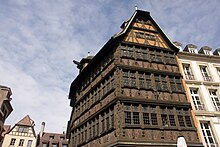Langoustine
Honoré Pierre André Laurent-Etienne Langustier is a fictional detective character of the German writer Tom Wolf .
figure
Langustier comes from Strasbourg in Alsace . He was born on February 12, 1702 as the son of the eagle host Alphonse René Antoine-François Augustin Langustier and his wife Elisabeth Langustier, a née Montgolfier, in the Kammerzell house on Münsterplatz. In 1723 he married Marie Louise Charlotte Haguenau from Lahr . In the same year his daughter Marie was born to him. Mrs. Marie Louise died in 1738.
On the transit of King Frederick the Great of Prussia in 1740, he got to know and appreciate the culinary art of the Alsatian innkeeper in the Rabenhof on Strasbourg's Quai des Bateliers and recruits the charming, highly educated and astute caterer for the royal Prussian court.
Already on arrival in Berlin, Langustier is confronted with a criminal case. Some astute observations and conclusions draw the king's attention to the other great talent of his now second court chef, and Friedrich entrusts him with the criminal investigation.
In 1767 Langustier married Rahel Schönermark and built a villa on the Heiligen See in Potsdam, which was destroyed in an air raid by Anglo-American bombers in 1945. Langustier dies on September 3, 1798 as a result of a carriage accident in Wissembourg.
A total of thirteen Langustier volumes have been published in the “ Preußenkrimis ” series by be.bra Verlag ; his successor is his great-granddaughter - Gerardine de Lalande - who has been identified in three novels so far.
Works by Honoré Langustier
- Seductive Culinary Art, 1769
- Memoires intimate, 1786
- Bleumorant, Conversations with Frederick the Single, 1806
Chronological order
- Honoré Langustier's Adventure
- 1740 - royal blue
- 1743 - silver gray
- 1746 - nutmeg brown
- 1750 - purple
- 1755 - Rosé Pompadour
- 1757 - sulfur yellow
- 1759 - emerald green
- 1760 - glowing orange
- 1766 - jet black
- 1772 - chalk white
- 1778 - blonde
- 1782 - night violet
- 1786 - crystal clear
- Gerardine de Lalandes adventure
- 1793 - The red salon
- 1798 - The last bastion
- 1810 - The Spanish medallion
source
Tom Wolf, The Last Bastion - Ein Gerardine de Lalande Krimi, be bra Verlag Berlin, 2011, ISBN 978-3-89809-519-8 , p. 262
Web links
- Detailed biography of the detective (PDF file; 87 kB)
